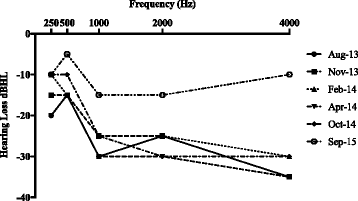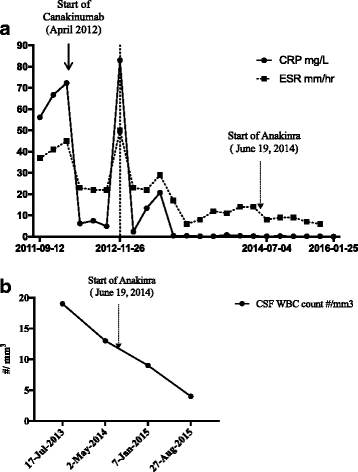Resolution of unilateral sensorineural hearing loss in a pediatric patient with a severe phenotype of Muckle-Wells syndrome treated with Anakinra: a case report and review of the literature
- PMID: 29382382
- PMCID: PMC5791344
- DOI: 10.1186/s40463-018-0256-0
Resolution of unilateral sensorineural hearing loss in a pediatric patient with a severe phenotype of Muckle-Wells syndrome treated with Anakinra: a case report and review of the literature
Abstract
Background: Muckle-Wells syndrome (MWS) is a rare auto-inflammatory disease characterized by the presence of recurrent urticaria, deafness and amyloidosis. Progressive sensorineural hearing loss (SNHL) is reported to occur in up to 85% of patients occurring in the second and third decades and as early as the first decade in patients with a more severe phenotype, thus potentially having a significant impact on a child's development. IL-1 inhibitors, such as Anakinra, have been described to improve systemic inflammation, and stabilize or improve hearing status as well. However, complete resolution of hearing loss has been rarely reported. The objective of this article is to highlight the clinical presentation of a pediatric patient with a severe form of MWS and report on the complete resolution of SNHL with the use of Anakinra.
Case presentation: A 3-year-old boy was referred to our hospital to assess for the possibility of MWS given a history of hives and recurrent episodes of fever with a family history of MWS in his mother. Of note, the patient's history was significant for conductive hearing loss, speech delay, as well as recurrent acute otitis media episodes. Genetic analysis was performed and diagnosis of MWS was confirmed due to the presence of a NLRP3 gene mutation. Further work-up demonstrated the presence of papilledema and elevation of systemic inflammatory markers for which Canakinumab was initiated. Despite initiation of this treatment, audiogram evaluation demonstrated a new right-sided SNHL. Lumbar puncture also revealed aseptic meningitis. Canakinumab was eventually discontinued and Anakinra initiated. Within 7 months of treatment with Anakinra at 5 mg/kg sc daily, resolution of the SNHL was observed. With further escalation of the Anakinra dose, there was also complete resolution of the aseptic meningitis.
Conclusions: Progressive hearing loss is a significant finding in patients with MWS. Early screening as well as initiation of Anakinra can lead to complete resolution of SNHL even in a patient with a severe spectrum of MWS. However, as this case demonstrates, longer treatment duration and higher doses of Anakinra may be required to achieve this.
Keywords: Anakinra; Hearing loss; Muckle-wells syndrome.
Conflict of interest statement
Ethics approval and consent to participate
This case report was conducted in the tertiary healthcare center of the Montreal Children’s Hospital of the McGill University Health Centre (MUHC). Ethical approval by the research ethics boards (REB) of the MUHC was obtained.
Consent for publication
Consent for publication was obtained by the patient and his legal guardians (patient’s parents in this case).
Competing interests
RS has received honoraria from Sobi Canada and Novartis Pharmaceuticals Canada. The other authors have no competing interests to declare.
Publisher’s Note
Springer Nature remains neutral with regard to jurisdictional claims in published maps and institutional affiliations.
Figures


Similar articles
-
Muckle-Wells syndrome: a treatable cause of congenital sensorineural hearing loss.B-ENT. 2013;9(2):161-3. B-ENT. 2013. PMID: 23909124
-
Early canakinumab therapy for the sensorineural deafness in a family with Muckle-Wells syndrome due to a novel mutation of NLRP3 gene.Clin Rheumatol. 2019 Mar;38(3):943-948. doi: 10.1007/s10067-018-4331-8. Epub 2018 Oct 18. Clin Rheumatol. 2019. PMID: 30338413
-
Efficacy and safety of anakinra therapy in pediatric and adult patients with the autoinflammatory Muckle-Wells syndrome.Arthritis Rheum. 2011 Mar;63(3):840-9. doi: 10.1002/art.30149. Arthritis Rheum. 2011. PMID: 21360513
-
Severe cryopyrin-associated periodic syndrome first characterized by early childhood-onset sensorineural hearing loss - Case report and literature review.Int J Pediatr Otorhinolaryngol. 2019 May;120:68-72. doi: 10.1016/j.ijporl.2019.01.037. Epub 2019 Jan 28. Int J Pediatr Otorhinolaryngol. 2019. PMID: 30772614 Review.
-
[Syndrome of Muckle-Wells and autoinflammatory familiar syndrome induced by cold].Med Clin (Barc). 2011 Jan;136 Suppl 1:16-21. doi: 10.1016/S0025-7753(11)70004-5. Med Clin (Barc). 2011. PMID: 21596182 Review. Spanish.
Cited by
-
Unveiling the Efficacy, Safety, and Tolerability of Anti-Interleukin-1 Treatment in Monogenic and Multifactorial Autoinflammatory Diseases.Int J Mol Sci. 2019 Apr 17;20(8):1898. doi: 10.3390/ijms20081898. Int J Mol Sci. 2019. PMID: 30999610 Free PMC article. Review.
-
IL-1R/C3aR signaling regulates synaptic pruning in the prefrontal cortex of depression.Cell Biosci. 2022 Jun 17;12(1):90. doi: 10.1186/s13578-022-00832-4. Cell Biosci. 2022. PMID: 35715851 Free PMC article.
-
Rational Design of Inner Ear Drug Delivery Systems.Adv Sci (Weinh). 2025 Aug;12(29):e2410568. doi: 10.1002/advs.202410568. Epub 2025 May 8. Adv Sci (Weinh). 2025. PMID: 40344640 Free PMC article. Review.
-
Involvement of NLRP3-inflammasome pathway in noise-induced hearing loss.Neural Regen Res. 2022 Dec;17(12):2750-2754. doi: 10.4103/1673-5374.339499. Neural Regen Res. 2022. PMID: 35662224 Free PMC article.
-
CD38 Coordinates with NF-κB to Promote Cochlear Inflammation in Noise-Induced Hearing Loss: the Protective Effect of Apigenin.Mol Neurobiol. 2025 May;62(5):6166-6178. doi: 10.1007/s12035-024-04675-7. Epub 2024 Dec 27. Mol Neurobiol. 2025. PMID: 39725836 Free PMC article.
References
Publication types
MeSH terms
Substances
LinkOut - more resources
Full Text Sources
Other Literature Sources

